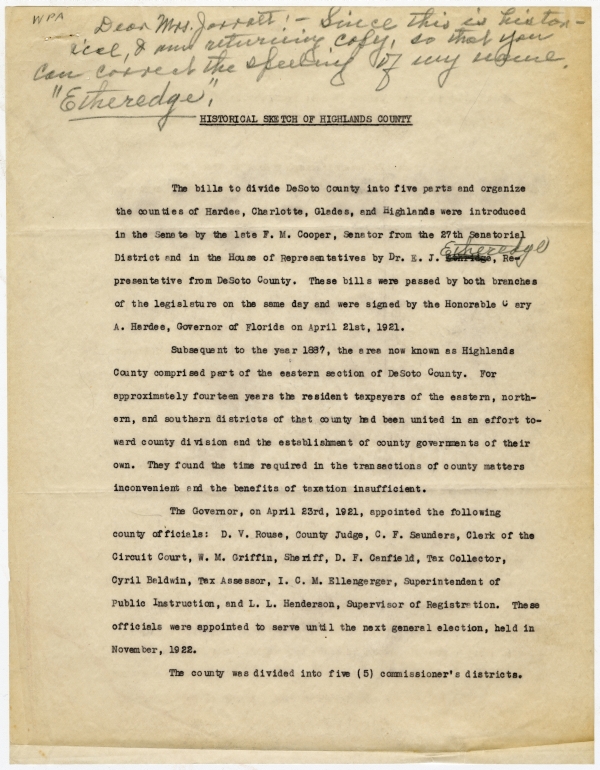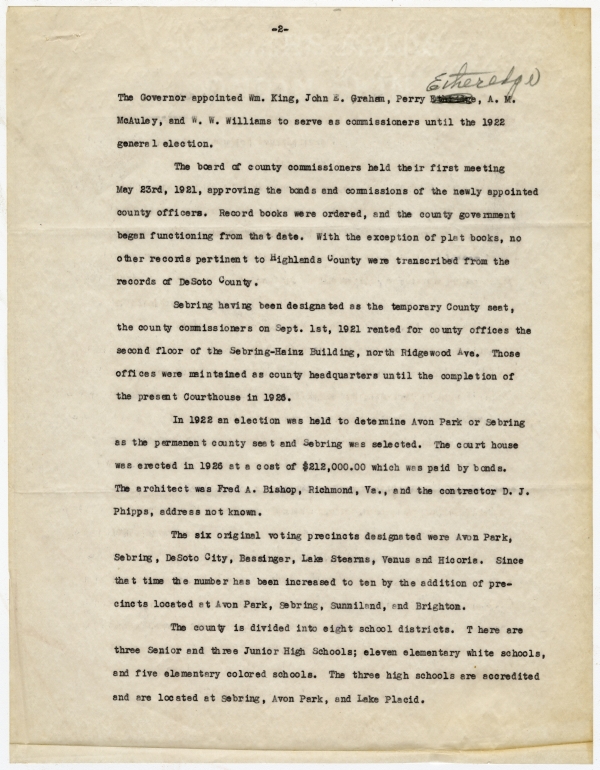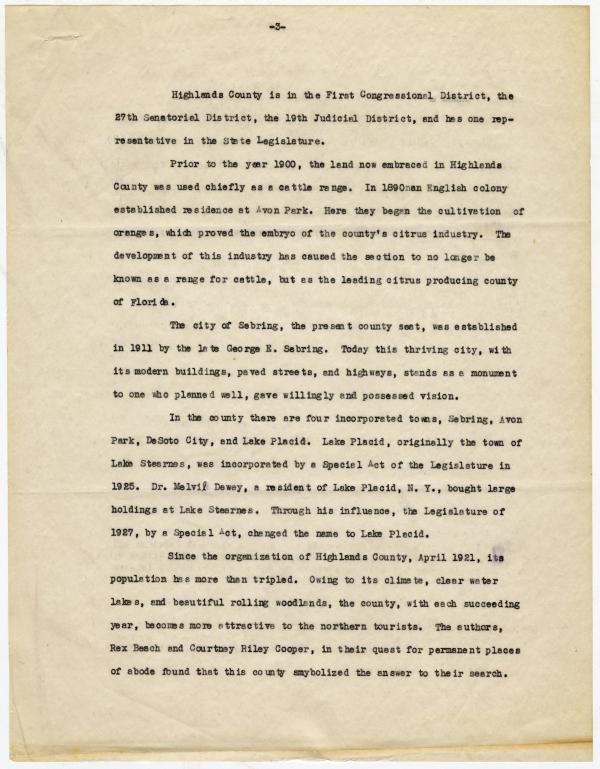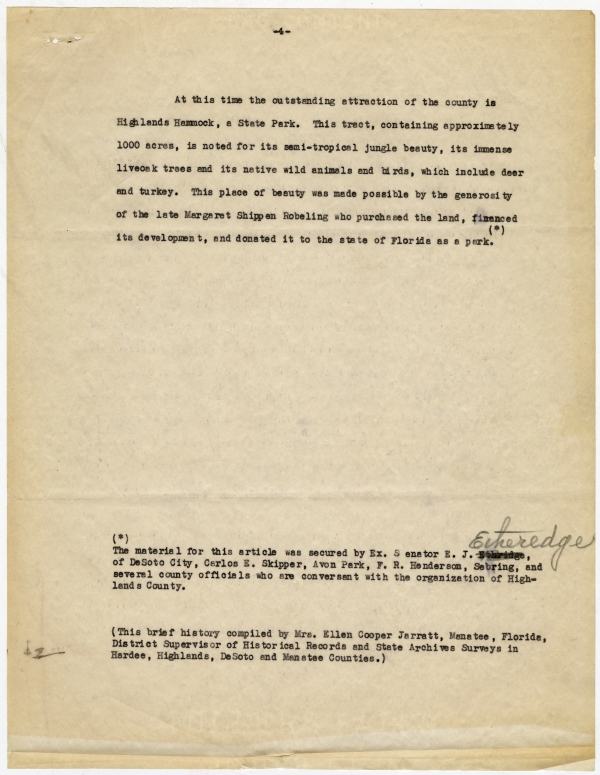WPA
Dear Mrs. Jarratt: Since this is historical, I am returning copy, so that you can correct the spelling of my [?]
"Etheredge."
HISTORICAL SKETCH OF HIGHLANDS COUNTY
The bills to divide DeSoto County into five parts and organize the counties of Hardee, Charlotte, Glades, and Highlands were introduced in the Senate by the late F. M. Cooper, Senator from the 27th Senatorial District and in the House of Representatives by Dr. E. J. Etheredge, Representative from DeSoto County. These bills were passed by both branches of the legislature on the same day and were signed by the Honorable Cary A. Hardee, Governor of Florida on April 21st, 1921.
Subsequent to the year 1887, the area now known as Highlands County comprised part of the eastern section of DeSoto County. For approximately fourteen years the resident taxpayers of the eastern, northern, and southern districts of that county had been united in an effort toward county division and the establishment of county governments of their own. The found the time required in the transactions of county matters inconvenient and the benefits of taxation insufficient.
The Governor, on April 23rd, 1921, appointed the following county officials: D. V. Rouse, County Judge, C. F. Saunders, Clerk of the Circuit Court, W. M. Griffin, Sheriff, D. F. Canfield, Tax Collector, Cyril Baldwin, Tax Assessor, I. C. M. Ellengerger, Superintendent of Public Instruction, and L. L. Henderson, Supervisor of Registration. These officials were appointed to serve until the next general election, held in November, 1922.
The county was divided into five (5) commissioner's districts.
-2-
The governor appointed Wm. King, John E. Graham, Perry Etheredge, A. M. McAuley, and W. W. Williams to serve as commissioners until the 1922 general election.
The board of county commissioners held their first meeting May 23rd, 1921, approving the bonds and commissions of the newly appointed county officers. Record books were ordered, and the county government began functioning from that date. With the exception of plat books, no other records pertinent to Highlands County were transcribed from the records of DeSoto County.
Sebring having been designated as the temporary County seat, the county commissioners on Sept. 1st, 1921 rented for county offices the second floor of the Sebring-Hainz Building, north Ridgewood Ave. Those offices were maintained as county headquarters until the completion of the present Courthouse in 1926.
In 1922 an election was held to determine Avon Park or Sebring as the permanent county seat and Sebring was selected. The court house was erected in 1926 at a cost of $212,000.00 which was paid by bonds. The architect was Fred A. Bishop, Richmond, Va., and the contractor D. J. Phipps, address not known.
The six original voting precincts designated were Avon Park, Sebring, DeSoto City, Bassinger, Lake Stearns, Venus and Hicoris. Since that time the number has been increased to ten by the addition of precincts located at Avon Park, Sebring, Sunniland, and Brighton.
The county is divided into eight school districts. There are three Senior and three Junior High Schools; eleven elementary white schools, and five elementary colored schools. The three high schools are accredited and are located at Sebring, Avon Park, and Lake Placid.
-3-
Highlands County is in the First Congressional District, the 27th Senatorial District, the 19th Judicial District, and has one representative in the State Legislature.
Prior to the year 1900, the land now embraced in Highlands County was used chiefly as a cattle range. In 1890 an English colony established residence at Avon Park. Here they began the cultivation of oranges, which proved the embryo of the county's citrus industry. The development of this industry has caused the section to no longer be known as a range for cattle, but as the leading citrus producing county of Florida.
The city of Sebring, the present county seat, was established in 1911 by the late George E. Sebring. Today this thriving city, with its modern buildings, paved streets, and highways, stands as a monument to one who planned well, gave willingly and possessed vision.
In the county there are four incorporated towns, Sebring, Avon Park, DeSoto City, and Lake Placid. Lake Placid, originally the town of Lake Stearnes, was incorporated by a Special Act of the Legislature in 1925. Dr. Melvil Dewey, a resident of Lake Placid, N. Y., bought large holdings at Lake Stearnes. Through his influence, the Legislature of 1927, by a Special Act, changed the name to Lake Placid.
Since the organization of Highlands County, April 1921, its population has more than tripled. Owing to its climate, clear water lakes, and beautiful rolling woodlands, the county, with each succeeding year, becomes more attractive to the northern tourists. The authors, Rex Beach and Courtney Riley Cooper, in their quest for permanent places of abode found that this county [symbolized] the answer to their search.
-4-
At this time the outstanding attraction of the county is Highlands Hammock, a State Park. This tract, containing approximately 1000 acres, is noted for its semi-tropical jungle beauty, its immense [live oak] trees and its native wild animals and birds, which include deer and turkey. This place of beauty was made possible by the generosity of the late Margaret Shippen Robeling who purchased the land, financed its development, and donated it to the state of Florida as a park. (*)
(*) The material for this article was secured by Ex. Senator E. J. Etheredge of DeSoto City, Carlos E. Skipper, Avon Park, F. R. Henderson, Sebring, and several county officials who are conversant with the organization of Highlands County.
(This brief history compiled by Mrs. Ellen Cooper Jarratt, Manatee, Florida, District Supervisor of Historical Records and State Archives Surveys in Hardee, Highlands, DeSoto and Manatee Counties.)




 Listen: The Latin Program
Listen: The Latin Program

